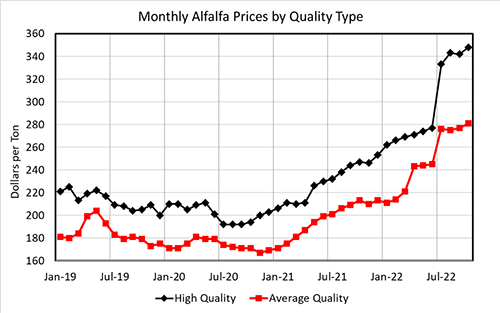
The alfalfa price figure used to determine Dairy Margin Coverage (DMC) feed costs was amended in the final rule released late last year. What was once calculated as the average of high quality and average quality alfalfa was changed to only consider the high-quality price.
When the final rule was announced, the difference between these two price series had averaged around $30 per ton, with a range of $18 to $45 since the high-quality alfalfa price series began to be published by USDA-NASS at the beginning of 2019.
Changing the formula was expected to raise the calculated DMC feed cost by around 20 cents per hundredweight (cwt.) on average, enough to result in a noticeable bump in DMC payments when margins were low enough to trigger program operation.
But market developments throughout 2022 have caused the impact of the formula change to be even larger. The spread between the five-state premium and supreme alfalfa hay price and the average alfalfa hay price first published by USDA-NASS (prices are subject to later revisions, but it is the first-released price that determines DMC feed costs and margins) has averaged nearly $50 per ton for the first 10 months of 2022. The last three months have averaged nearly $67 per ton.
With DMC margins below $9 per cwt. in both August and September, producers who signed up for coverage at the highest margin levels received a notable bump in their DMC payment due to last year’s formula change for alfalfa hay. The new formula provided covered producers with a payment that was, on average, 45 cents per cwt. higher for eligible milk over the two-month period.
It is difficult to project how long that these wider price spreads will continue in alfalfa markets. With USDA-NASS computing the high-quality hay price as the weighted average of the five largest milk producing states (California, Wisconsin, Texas, Idaho and New York in recent years), growing conditions in these areas could be a contributing factor. The 2022 alfalfa production estimates released by USDA in October included a 4.8% decline in these five states relative to a 0.9% decline for total U.S. alfalfa production.
The bottom line
The recent market conditions have made the alfalfa price formula adjustment an even larger positive factor in 2022 than previously expected. This will likely carry over into 2023 to some extent, and is yet another factor to consider when making your 2023 DMC coverage decision.









